Comparison of Potential Risk on Two Managed Aquifer Recharge Sites from River Basin
Abstract
:1. Introduction
2. Study Area and Managed Aquifer Recharge
2.1. Study Area
2.2. Two Types of Managed Aquifer Recharge
3. Methods and Materials
3.1. Definition of Potential Risk
3.2. Generation of Potential Risk
3.3. Input Data
4. Results and Discussion
4.1. Exceedance Probability of Potential Risk
4.2. Return Period of Potential Risk
4.3. Discussion
5. Conclusions
Acknowledgments
Author Contributions
Conflicts of Interest
References
- Capel, P.D.; Giger, W.; Reichert, P.; Wanner, O. Accidental input of pesticides into the Rhine River. Environ. Sci. Technol. 1988, 22, 992–997. [Google Scholar] [CrossRef] [PubMed]
- Kim, D.H.; Lee, S.K.; Chun, B.Y.; Lee, D.H.; Hong, S.C.; Jang, B.K. Illness associated with contamination of drinking water supplies with phenol. J. Korean Med. Sci. 1994, 9, 218–223. [Google Scholar] [CrossRef] [PubMed]
- Cooper, W.J. Responding to crisis: The West Virginia chemical spill. Environ. Sci. Technol. 2014, 48, 3095. [Google Scholar] [CrossRef] [PubMed]
- National Response Center (NRC) Data Download. Available online: http://nrc.uscg.mil/ (accessed on 5 September 2017).
- K-Water. Available online: http://www.water.or.kr/wstatic/easy/easys030101.do (accessed on 1 December 2016).
- Dore, M.H. Global Drinking Water Management and Conservation, Optimal Decision-Making; Springer: Cham, Switzerland, 2014; pp. 117–136. [Google Scholar]
- Business Dictionary. Available online: http://www.businessdictionary.com/definition/risk.html (accessed on 16 January 2016).
- Jiang, J.; Wang, P.; Lung, W.S.; Guo, L.; Li, M. A GIS-based generic real-time risk assessment framework and decision tools for chemical spills in the river basin. J. Hazard. Mater. 2012, 227, 280–291. [Google Scholar] [CrossRef] [PubMed]
- Bryant, D.L.; Abkowitz, M.D. Estimation of terrestrial chemical spill risk factors using a modified Delphi approach. J. Environ. Manag. 2007, 85, 112–120. [Google Scholar] [CrossRef] [PubMed]
- Lim, S.R.; Lam, C.W.; Schoenung, J.M. Priority screening of toxic chemicals and industry sectors in the US toxics release inventory: A comparison of the life cycle impact-based and risk-based assessment tools developed by US EPA. J. Environ. Manag. 2011, 92, 2235–2240. [Google Scholar] [CrossRef] [PubMed]
- Ariyadasa, B.; Kondo, A.; Inoue, Y. Screening for potentially hazardous PRTR chemicals in the Lake Biwa-Yodo River basin of Japan using a one-box multimedia model. Environ. Sci. Pollut. Res. 2015, 22, 2757–2764. [Google Scholar] [CrossRef] [PubMed]
- Bartram, J.; Corrales, L.; Davison, D.; Drury, D.; Gordon, B.; Howard, G.; Rinehold, A.; Stevens, M. Water Safety Plan Manual: Step-by-Step Risk Management for Drinking-Water Suppliers; World Health Organization: Geneva, Switzerland, 2009. [Google Scholar]
- Havelaar, A.H. Application of HACCP to drinking water supply. Food Control 1994, 5, 145–152. [Google Scholar] [CrossRef]
- Ji, H.W.; Lee, S.-I. Assessment of risk due to chemicals transferred in a watershed: A case of an aquifer storage transfer and recovery site. Water 2016, 8, 242. [Google Scholar] [CrossRef]
- Ji, H.W.; Lee, S.-I. Use of pollutant release and transfer register (PRTR) to assess potential risk associated with chemicals in a drinking water supply facility. Desalination Water Treat. 2016, 57, 29228–29239. [Google Scholar] [CrossRef]
- Jung, S.-H.; Park, H.-K.; Lee, H.-J.; Lee, S.-H. Effect of climate change for diatom bloom at winter and spring season in Mulgeum Station of the Nakdong River, South Korea. J. Korean Soc. Water Environ. 2013, 29, 155–164. (In Korean) [Google Scholar]
- Lee, J.-K.; Kim, T.-O.; Jung, Y.-J. Analysis of domestic water pollution accident and response management. J. Wetl. Res. 2013, 15, 529–534. (In Korean) [Google Scholar] [CrossRef]
- Seo, J.Y.; Lee, S.-I. Integration of GRACE, ground observation, and land-surface models for groundwater storage variations in South Korea. Int. J. Remote Sens. 2016, 37, 5786–5801. [Google Scholar] [CrossRef]
- Dillon, P. Future management of aquifer recharge. Hydrogeol. J. 2005, 13, 313–316. [Google Scholar] [CrossRef]
- Maliva, R.G.; Missimer, T.M. Aquifer Storage and Recovery and Managed Aquifer Recharge Using Wells: Planning, Hydrogeology, Design and Operation; Schlumberger: Sugar Land, TX, USA, 2010; pp. 8–9. [Google Scholar]
- Missimer, T.M.; Guo, W.; Maliva, R.G.; Rosas, J.; Jadoon, K.Z. Enhancement of wadi recharge using dams coupled with aquifer storage and recovery wells. Environ. Earth Sci. 2015, 73, 7723–7731. [Google Scholar] [CrossRef]
- Levantesi, C.; La Mantia, R.; Masciopinto, C.; Böckelmann, U.; Ayuso-Gabella, M.N.; Salgot, M.; Tandoi, V.; Van Houtte, E.; Wintgens, T.; Grohmann, E. Quantification of pathogenic microorganisms and microbial indicators in three wastewater reclamation and managed aquifer recharge facilities in Europe. Sci. Total Environ. 2010, 408, 4923–4930. [Google Scholar] [CrossRef] [PubMed]
- Parsons, S.; Dillon, P.; Irvine, E.; Holland, G.; Kaufman, C. Progress in Managed Aquifer Recharge in Australia; Waterlines Report; National Water Commission: Canberra, Australia, 2012; pp. 11–12. [Google Scholar]
- United States Environmental Protection Agency (EPA). Available online: https://www.epa.gov/uic/aquifer-recharge-and-aquifer-storage-and-recovery (accessed on 28 July 2017).
- Callahan, M.; Vaughan, E.G.; Crutcher, J.M.; Labatt, T.W., III; McMahan, L.H.; Bradford, B.R., Jr.; Cluck, M. 2012 State Water Plan; Texas Water Development Board: Austin, TX, USA, January 2012.
- Lee, D.; No, J.H.; Kim, H.C.; Choi, J.W.; Choi, I.H.; Maeng, S. Effect of silver nanoparticles on the performance of riverbank filtration: Column study. J. Korean Soc. Water Wastewater 2015, 29, 77–88. (In Korean) [Google Scholar] [CrossRef]
- Lee, E.; Hyun, Y.; Lee, K.-K.; Kim, H.-S.; Jeong, J.-H. Evaluation of well production by a riverbank filtration facility with radial collector well system in Jeungsan-ri, Changnyeong-gun, Korea. J. Soil Groundw. Environ. 2010, 15, 1–12. (In Korean) [Google Scholar]
- Matsui, S. Drainage basin security of hazardous chemical fluxe in the Yodo River basin. Water Sci. Technol. 2004, 49, 189–197. [Google Scholar] [PubMed]
- Ozaki, M.; Suwa, M.; Suzuki, Y. Study on risk management of heavy metals for reuse of biosolids. Water Sci. Technol. 2006, 53, 189–195. [Google Scholar] [CrossRef] [PubMed]
- Hartmann, J.; Okada, N.; Levy, J.K. Integrated disaster risk management strategy to prevent exposure to hazardous substances due to inundation triggered releases: A concept for Japan. J. Nat. Disaster Sci. 2004, 26, 87–93. [Google Scholar]
- Sekizawa, J.; Ohtawa, H.; Yamamoto, H.; Okada, Y.; Nakano, T.; Hirai, H.; Yamamoto, S.; Yasuno, K. Evaluation of human health risks from exposures to four air pollutants in the indoor and the outdoor environments in Tokushima, and communication of the outcomes to the local people. J. Risk Res. 2015, 10, 841–851. [Google Scholar] [CrossRef]
- Fred, T.; Heinonen, M.; Sundell, L.; Toivikko, S. Air emissions at large municipal wastewater treatment plants in Finland for national E-PRTR reporting register. Water Pract. Technol. 2009, 4. [Google Scholar] [CrossRef]
- Hoshi, J.Y.; Amano, S.; Sasaki, Y.; Korenaga, T. Investigation and estimation of emission sources of 54 volatile organic compounds in ambient air in Tokyo. Atmos. Environ. 2008, 42, 2383–2393. [Google Scholar] [CrossRef]
- United States Environmental Protection Agency (EPA). Toxics Release Inventory; United States Environmental Protection Agency: Washington, DC, USA, 1995.
- The Organisation for Economic Co-operation and Development (OECD). ENV/EPOC(2000)8/FINAL. 2000. Available online: http://www.oecd.org/officialdocuments/displaydocument/?doclanguage=en&cote=env/epoc(2000)8/final (accessed on 5 September 2017).
- PRTR Information System. Available online: http://ncis.nier.go.kr/triopen (accessed on 3 March 2017).
- National Institute of Chemical Safety. Available online: http://kischem.nier.go.kr/kischem2/wsp/main/main.jsp (accessed on 2 May 2015).
- National Fire Protection Association (NFPA). NFPA 704: Standard System for the Identification of the Hazards of Materials for Emergency Response, 2012 ed.; NFPA: Boston, MA, USA, 2012; pp. 8–16. [Google Scholar]
- Lee, S.I.; Lee, S.S. Site suitability analysis for riverbank filtration using game theory. J. Korea Water Resour. Assoc. 2010, 43, 95–104. (In Korean) [Google Scholar] [CrossRef]
- Brown, C.J.; Ward, J.; Mirecki, J. A revised brackish water aquifer storage and recovery (ASR) site selection index for water resources management. Water Resour. Manag. 2016, 30, 2465–2481. [Google Scholar] [CrossRef]
- Brown, C.J.; Weiss, R.; Verrastro, R.; Schubert, S. Development of an aquifer, storage and recovery (ASR) site selection suitability index in support of the comprehensive everglades restoration project. J. Environ. Hydrol. 2005, 13, 20. [Google Scholar]
- Rahman, M.A.; Rusteberg, B.; Gogu, R.C.; Ferreira, J.L.; Sauter, M. A new spatial multi-criteria decision support tool for site selection for implementation of managed aquifer recharge. J. Environ. Manag. 2012, 99, 61–75. [Google Scholar] [CrossRef] [PubMed]
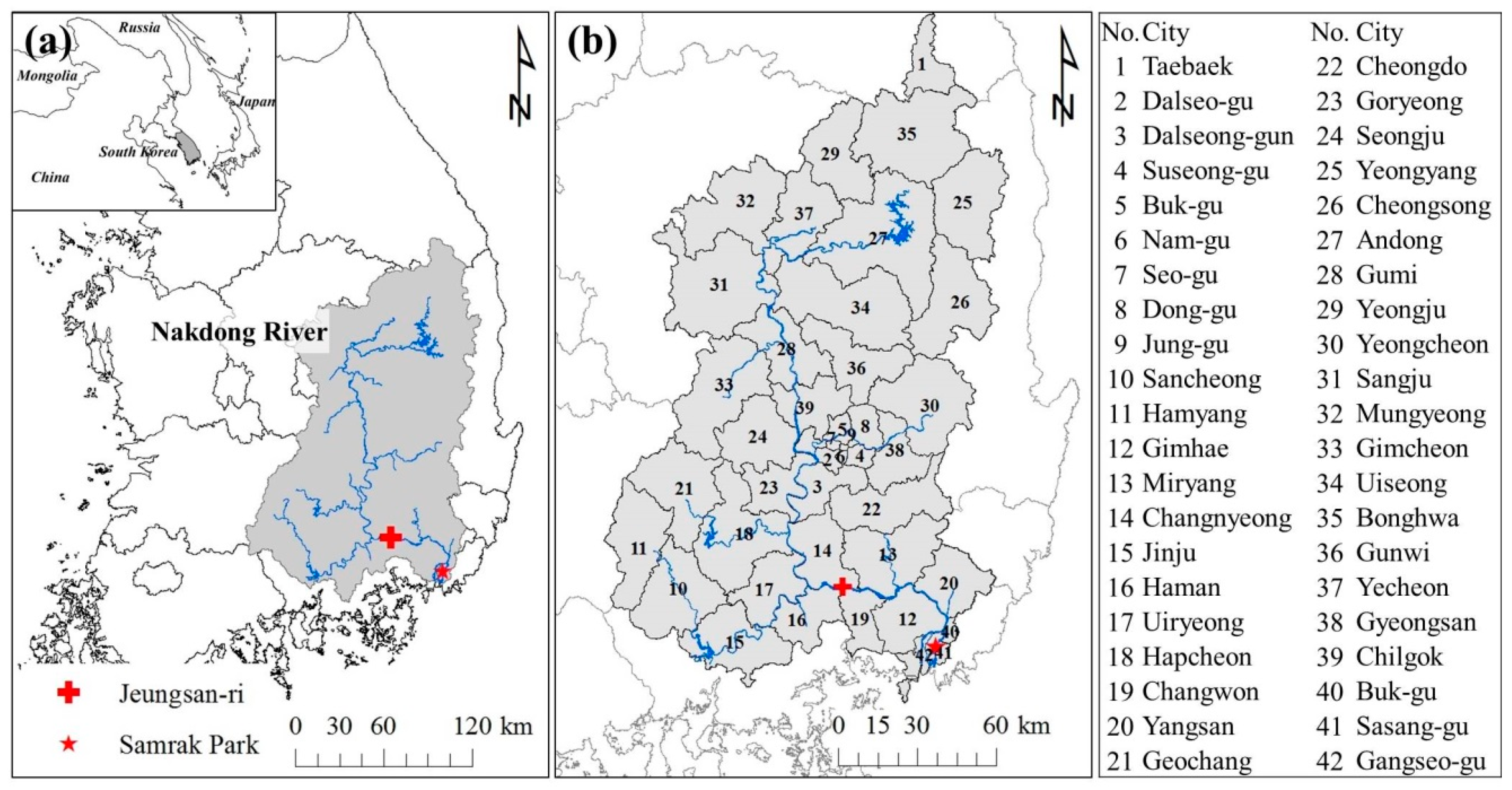
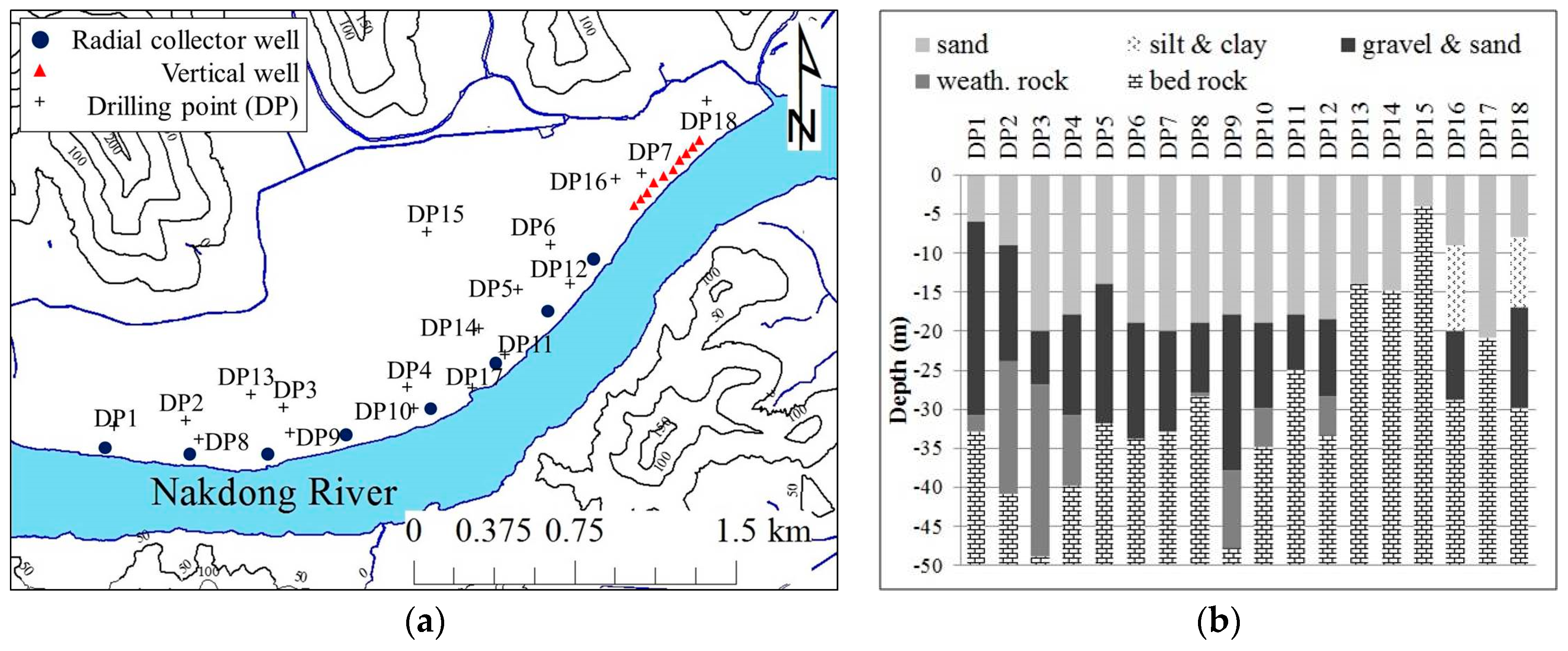
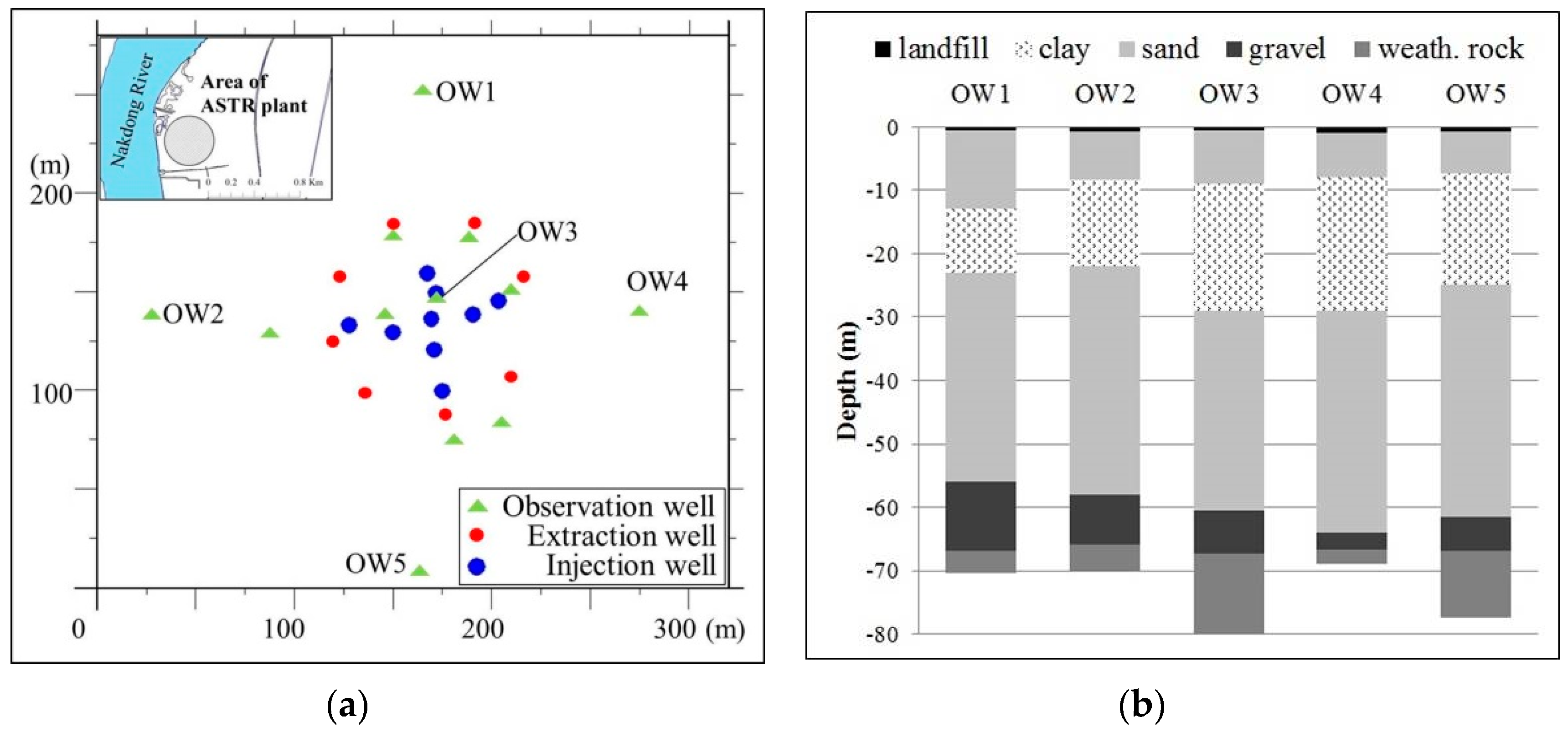
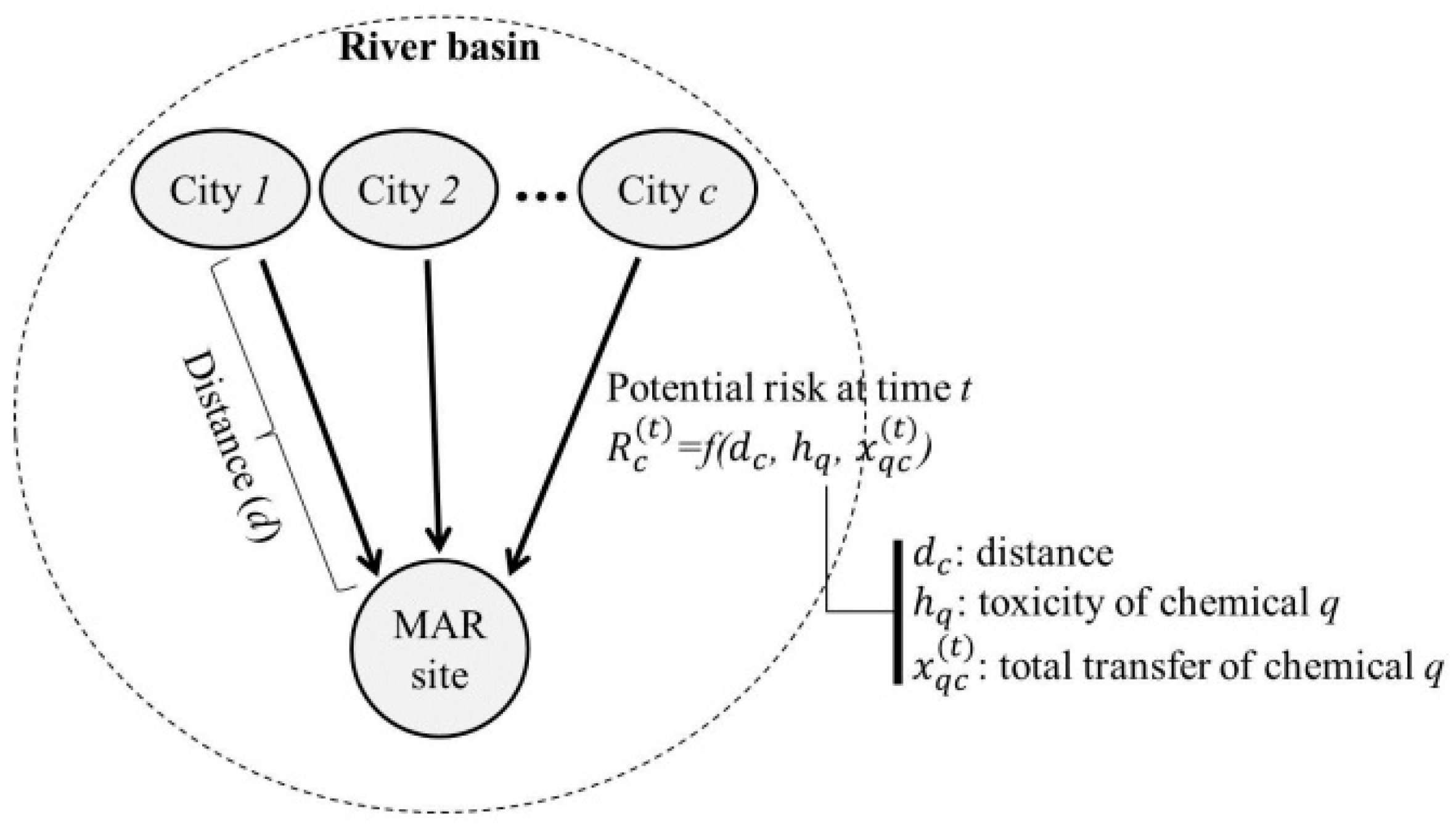
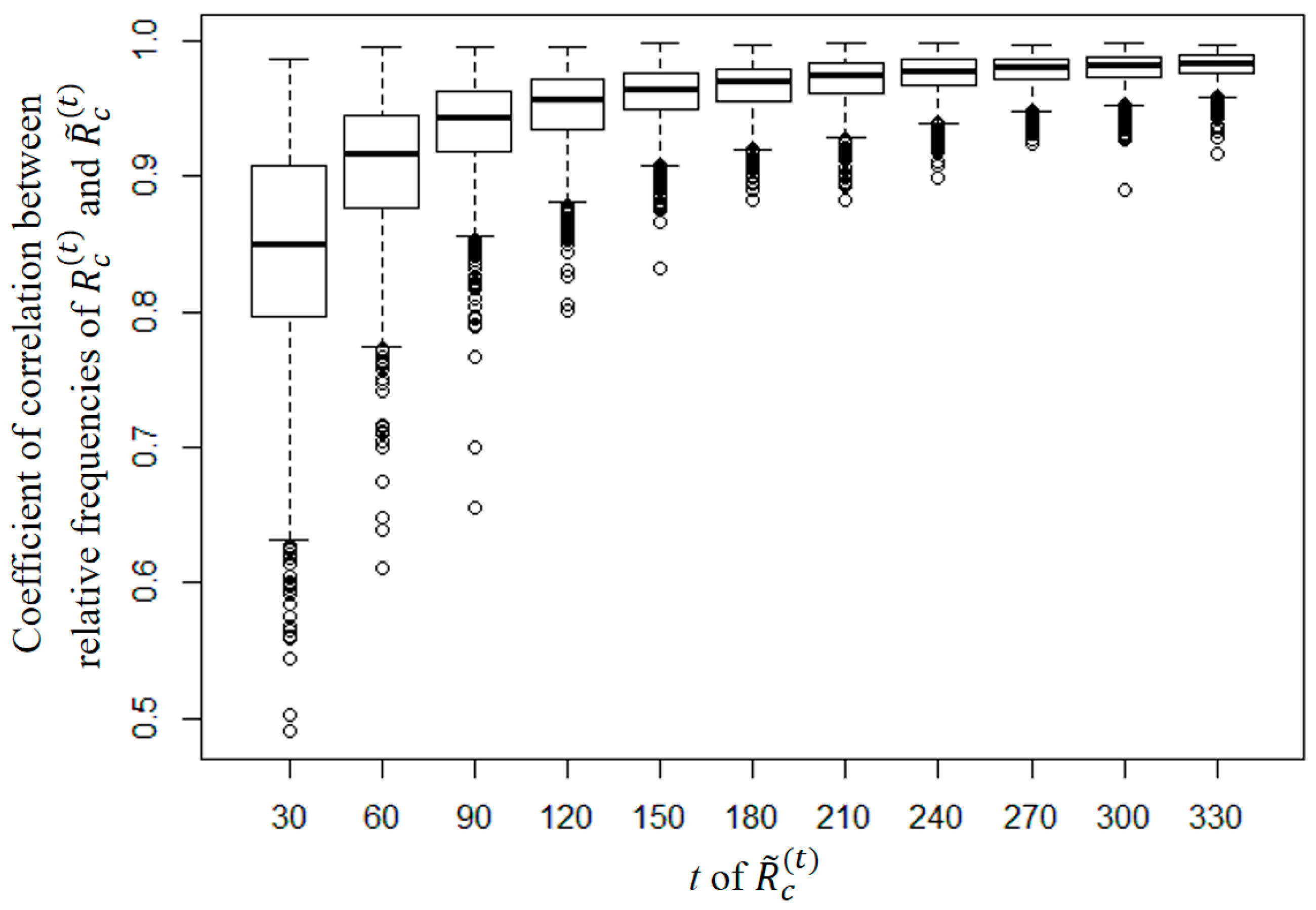



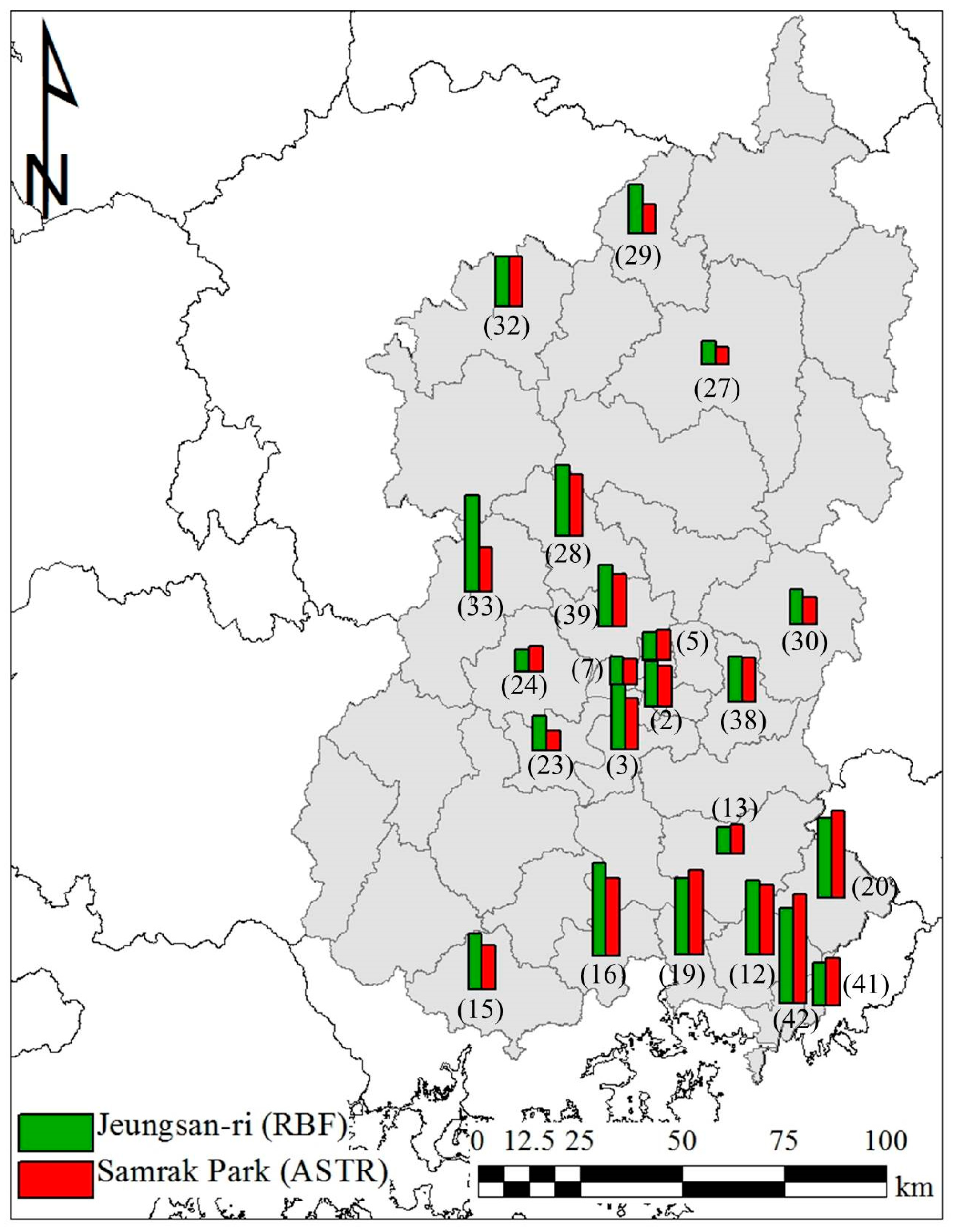
| Contents | Jeungsan-Ri Case (RBF) | Samrak Park Case (ASTR) |
|---|---|---|
| Location | South of city No. 41 | West of city No. 14 |
| Distance from the Nakdong River mouth | 75 km | 9 km |
| MAR type | Riverbank filtration (RBF) | Aquifer storage transfer and recovery (ASTR) |
| Schematic |  | 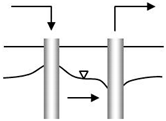 |
| Aquifer type | Unconfined aquifer | Confined aquifer |
| Depth of target aquifer | 20–30 m | 40–70 m |
| Supply | 680,000 m3/day | 100,000 m3/day |
| Storage | - | 107 m3 |
| Step | Content |
|---|---|
| 1 | Construct a frequency table of . |
| 2 | Replace relative frequencies of zero with a small number δ/n, where n is the number of relative frequencies of zero. |
| 3 | Multiply 1 − δ by other relative frequencies. |
| 4 | Calculate the cumulative relative frequency (). |
| 5 | Generate potential risk by assigning the class mark in accordance with a random number between 0 and 1, which is considered as the cumulative relative frequency. |
| 6 | Fit the generated potential risk () to an optimal probability distribution. |
| Emission Ranking | CAS No. | Chemicals | Toxicity 1 | Emisson (Tonnes) |
|---|---|---|---|---|
| 1 | 1330-20-7 | Xylene | 2 | 17,661 (32.5%) |
| 2 | 108-88-3 | Toluene | 2 | 8538 (15.7%) |
| 3 | 141-78-6 | Ethyl acetate | 1 | 4222 (7.8%) |
| 4 | 78-93-3 | Methylethylketone | 1 | 3422 (6.3%) |
| 5 | 100-41-4 | Ethylbenzene | 2 | 2821 (5.2%) |
| 6 | 67-56-1 | Methyl alcohol | 1 | 2716 (5.0%) |
| 7 | 75-09-2 | Dichloromethane | 2 | 2588 (4.8%) |
| 8 | 67-63-0 | Isopropanol | 1 | 2313 (4.3%) |
| 9 | 68-12-2 | N,N-Dimethylformamide | 1 | 1124 (2.1%) |
| 10 | 106-97-8 | Butane | 1 | 742 (1.4%) |
| Rank | Jeungsan-Ri (RBF) | Return Period | Samrak Park (ASTR) | Return Period | ||||
|---|---|---|---|---|---|---|---|---|
| 10 | 50 | 100 | 10 | 50 | 100 | |||
| 1 | Haman (16) | 20.20 | 22.11 | 22.79 | Gangseo-gu (42) | 21.29 | 25.23 | 26.63 |
| 2 | Gangseo-gu (42) | 19.00 | 22.12 | 23.22 | Yangsan (20) | 19.61 | 21.06 | 21.53 |
| 3 | Yangsan (20) | 18.46 | 19.53 | 19.87 | Changwon (19) | 18.43 | 20.38 | 21.07 |
| 4 | Changwon (19) | 18.17 | 18.68 | 18.84 | Haman (16) | 17.17 | 18.50 | 18.93 |
| 5 | Gimhae (12) | 16.40 | 17.71 | 18.17 | Gimhae (12) | 14.89 | 16.47 | 17.02 |
| 6 | Gumi (28) | 16.23 | 17.25 | 17.58 | Gumi (28) | 13.86 | 14.92 | 15.27 |
| 7 | Dalseong-gun (3) | 15.24 | 17.89 | 18.74 | Chilgok (41) | 11.31 | 11.64 | 11.74 |
| 8 | Gimcheon (33) | 14.54 | 20.92 | 23.62 | Sasang-gu (39) | 10.48 | 12.37 | 12.97 |
| 9 | Sasang-gu (39) | 12.26 | 14.36 | 15.02 | Dalseong-gun (3) | 10.25 | 12.03 | 12.63 |
| 10 | Jinju (15) | 10.55 | 12.93 | 13.77 | Gimcheon (33) | 9.63 | 10.50 | 10.79 |
© 2017 by the authors. Licensee MDPI, Basel, Switzerland. This article is an open access article distributed under the terms and conditions of the Creative Commons Attribution (CC BY) license (http://creativecommons.org/licenses/by/4.0/).
Share and Cite
Ji, H.W.; Lee, S.-I. Comparison of Potential Risk on Two Managed Aquifer Recharge Sites from River Basin. Water 2017, 9, 674. https://doi.org/10.3390/w9090674
Ji HW, Lee S-I. Comparison of Potential Risk on Two Managed Aquifer Recharge Sites from River Basin. Water. 2017; 9(9):674. https://doi.org/10.3390/w9090674
Chicago/Turabian StyleJi, Hyon Wook, and Sang-Il Lee. 2017. "Comparison of Potential Risk on Two Managed Aquifer Recharge Sites from River Basin" Water 9, no. 9: 674. https://doi.org/10.3390/w9090674





